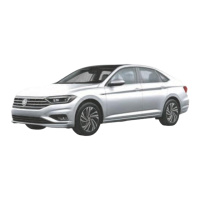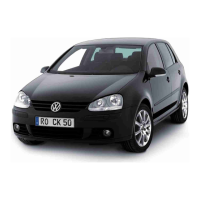ACC may not react, or may react late or
inappropriately, in the following driving situations:
:
—
In the case of vehicles driving outside the
sensor zone within a short distance of your
vehicle,
e.g. motorbikes → fig. 121.
—
In the case of vehicles changing lanes at a very
close distance to the vehicle → Fig. 122.
—
In the case of vehicles with accessories that
overhang the vehicle.
Switching ACC on and off
Please note at the beginning of this chapter on
page 140.
Fig. 123 Left side of the multi-function steering wheel:
ACC control buttons.
Connect
—
Press the key .
ACC does not yet regulate; the control indicator light
for the driving situation in question comes on.
Initiate regulation
—
During forward travel, press the key .
ACC saves the current speed and maintains the set
distance. If the current speed is outside the preset
speed range, ACC sets the minimum speed (if
driving slowly) or the maximum speed (if driving
fast).
Depending on the driving situation in question
and the version of the instrument cluster, the
following indicator lights are displayed:
The ACC is regulating.
ACC is regulating, not detected
o
no vehicle ahead.
The PCA is regulating, it has been
detected that the
o
a vehicle in front of it.
When ACC does not regulate, the control lamps are
not lit or are greyed out.
Disrupting regulation
—
Briefly press the button or step on the
brake pedal.
The control lamp corresponding to the driving
situation in question lights up; speed and
distance remain stored.
If the anti-skid control (ASR) is switched off, the
control is automatically interrupted.
Re-regulation
—
Press the key .
ACC picks up the last set speed and distance. The
set speed is shown on the instrument panel display
and the control indicator corresponding to the
driving situation lights up.
Disconnect
—
Press and hold the key . The set
speed is deleted.
Switch to speed limiter
1.
Press the key .
2.
Select the speed limiter in the instrument panel.
ACC is switched off.

